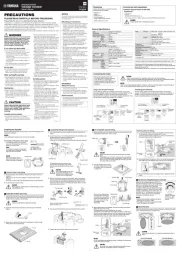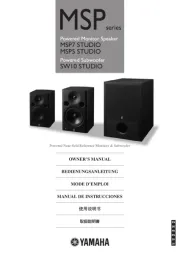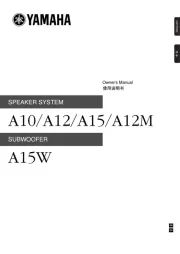Input the output signal from a source, such as a mixer, to the INPUT jack of the DXS, and input the output
signal from the OUTPUT jack of the DXS to the input jack of a full-range speaker.
• X-OVER switch (!2)
It is recommended that you match the crossover frequency (the cutoff frequency of the low pass filter)
of the DXS and the cutoff frequency of the high pass filter of the full-range speaker. The same fre-
quency range output from the DXS and the full-range speaker may cause interference with each other
and degrade the frequency characteristics.
• THROUGH/HPF POST switch (o)
If the full-range speaker is properly equipped with a high pass filter, you should set this to
[THROUGH]. The [THROUGH] setting enables you to control the level independently and minimize
signal delay. If the full-range speaker is not equipped with a high pass filter or the high pass filter in the
full-range speaker cannot be set to the same cutoff frequency as that of the low pass filter of the DXS,
set this to [HPF POST] to use the high pass filter in the DXS.
This is a pole socket used to mount a full-range speaker atop the DXS. The pole socket is compatible with
35 mm or M20 speaker poles, available commercially. When using the pole socket, be sure that the follow-
ing conditions are met.
Installing optional wheels SPW-1 at the back of the DXS enables you to transport the unit easily. To install
the wheels, use the screws already installed in the DXS unit.
Please do not use the speaker once the screws are removed. This causes air leaks to occur in enclosure,
resulting in undesirable performance.
* If any specific problem should persist, please contact your Yamaha dealer.
* The cont ent s of this manual apply to the latest specifications as of the publishing date.
To obtain the latest manual, access the Yamaha website then download the manual file.
Basic Setup
CAUTION
If multiple powered speakers are connected in daisy-chain fashion, turn each device on
in sequence starting from the one nearest to the sound source, and turn them off start-
ing from the one farthest from the sound source.
Combination of monaural DXS and stereo full-range speakers
Combination of stereo DXS and stereo full-range speakers
NOTE
The L and R jacks are interchangeable; there is no difference in behavior between them.
Full-range
speaker
Full-range speaker Full-range speaker
Mixer
DXS DXS
From mixer
To full-range speaker
Installing a Speaker Pole
Subwoofer Top-mounted speaker Pole length
DXS18 Weight 28.0 kg or less, height 76 cm or less (DSR115) 120 cm or less
DXS15mkII Weight 19.3 kg or less, height 61 cm or less (DXR12) 100 cm or less
DXS12mkII Weight 14.6 kg or less, height 51 cm or less (DXR10) 82 cm or less
Weight 13.5 kg or less, height 46 cm or less (DXR8) 90 cm or less
Installing Wheels
CAUTION
• For details on installing the wheels or special precautions you should take, please
refer to the relevant manual for the wheels.
• Do not install wheels other than the SPW-1.
Troubleshooting
Symptom Possible causes Possible solution
Power does not tur n on. The power cord is not con-
nected properly. Connect the power cord properly.
Power suddenly turned
off.
The protection system has
been activated, shutting
down the power supply.
Turn off the power, wait until the amplifier cools down,
and then turn on again.
No sound. The cable is not con-
nected properly. Connect the cable to the INPUT jack properly.
Sound is interrupted
suddenly.
The protection circuit has
been activated, muting the
output.
Wait until the amplifier cools down. If the unit doesn’t
automatically reset itself, turn off the power, and then
on again.
Sound howls (feed-
back).
A microphone is directed
toward the speaker.
Keep the speaker away from the area where the
microphone picks up the sound.
The sound from each
speaker differs (if multi-
ple speakers are used.)
The settings for each
speaker differ.
Set each switch of each speaker to the same posi-
tion.
Sound is distorted.
Input volume is excessive. Lower the volume of the input device so that the
PEAK indicator lights only occasionally.
Output volume is exces-
sive.
Lower the output level with the LEVEL control so that
the LIMIT indicator lights only occasionally.
General Specifications
General Specifications DXS18 DXS15mkII DXS12mkII
System Type Powered subwoofer, band-pass type
Frequency Range (-10 dB) 32 Hz–120 Hz 40 Hz–150 Hz 42 Hz–150 Hz
Measured Maximum SPL (Peak)
Pink Noise @1m 136 dB SPL 135 dB SPL 134 dB SPL
Power
Amplifier
Power
Rating
Dynamic 1,020 W
Continuous 800 W
Power Consumption
(1/8 output power) 100 W
Components LF 18" cone,
4" voice coil
15" cone,
2.5" voice coil
12" cone,
2.5" voice coil
Dimensions
(W × H × D; including rubber feet) 563 × 683 × 721 mm 480 × 611 × 614 mm 400 × 567 × 570 mm
Weight 49.7 kg 36.0 kg 30.0 kg
Handles Steel, side × 2
Pole Sockets (top surface) Ø35 mm (depth: 80 mm), M20 (threaded depth: 25 mm)
Connectors
Input XLR3-31 × 2
Output XLR3-32 × 2 (THROUGH or HPF POST)
Power IEC AC inlet × 1 (V-Lock)
Input Sensitivity (LEVEL: center) +10 dBu
Maximum Input Level +24 dBu
M20 screwØ35
qPole sockets
Adapts to commercially available speaker poles of 35 mm diameter and
M20 screws. For details on installing speaker poles, refer to “Installing
a Speaker Pole.”
wFeet cups
When stacking multiple DXS units, align the rubber feet of the upper
DXS unit to the feet cups of the lower.
eFront LED
Turns on when the power is on. Lights more brightly when the output
limiter is active. Using FRONT LED DISABLE switch (!9) allows you
to defeat the front LED altogether.
rWheel mounting holes
Optional SPW-1 wheels can be installed at these locations. For details
on installing the wheels or special precautions you should take, please
refer to the relevant manual for the wheels.
tAC IN inlet (V-Lock)
Connect the AC power cord included with the unit. The AC power cord
includes a locking mechanism with a latch. First connect the DXS to the
AC power cord, and then connect the power cord to the AC outlet.
When removing the cord, push the latch while pulling the cord out.
yPower switch
Turns the power to the unit on ( ) or off ( ).
If you are using multiple units, turn on the power to each unit one by
one. If you turn on the power to multiple units simultaneously, a tempo-
rary drop in the power voltage may occur, possibly resulting in abnor-
mal operation of the units.
Also, rapidly turning the unit on and off in succession can cause it to
malfunction. After turning the unit off, wait for about 5 seconds before
turning it on again.
uINPUT jacks
These are balanced input XLR jacks (line-level), and this device outputs
the mixed signals of L and R.
iOUTPUT jacks
These are balanced output XLR jacks for connecting full-range speak-
ers or additional DXS units. The output signal can be switched via the
THROUGH/HPF POST switch (o).
L/R output from the OUTPUT jacks correspond to L/R input to the
INPUT jacks. The mixed signal of L/R is not output.
oTHROUGH/HPF POST switch
Switches the signals output from the OUTPUT jacks (i).
•THROUGH: Outputs unaffected signals from INPUT jacks (u).
Select when using HPF of the connected speaker or connecting addi-
tional DXS units.
•HPF POST: Outputs signal input from INPUT jacks (u) after pass-
ing through a HPF. The cutoff frequency of the high pass filter is the
frequency specified with the X-OVER switch ( ). Because the out-!2
put level from the OUTPUT jacks is linked to the LEVEL control
(!1), the levels of this unit and the full-range speaker change simulta-
neously.
!0 PEAK indicator
Lights red when the input level reaches 3 dB below clipping. If the indi-
cator lights frequently, adjust the volume of the input source or lower
the LEVEL control (!1) so that the indicator flashes only briefly at the
highest input levels.
!1 LEVEL control
Adjusts the output level.
!2 X-OVER switch
Specifies the crossover frequency at 120 Hz, 100 Hz, or 80 Hz. The out-
put from the unit is processed through a low pass filter to cut the range
of the selected frequency or higher. When setting THROUGH/HPF
POST switch (o) to [HPF POST], the output signals from the OUT-
PUT jacks are processed through a high pass filter to cut the range of
the selected frequency or lower, and the crossover frequency is linked to
that of the connected speaker.
!3 D-XSUB switch
Switches the low-range frequency response characteristics.
•NORMAL: A generic setting corresponding to various applications.
•BOOST: Boosts the frequency range enhancing and providing punch
to the sound.
•XTD LF (eXTenDed LF): Extends the bottom of the low frequency
range.
!4 CARDIOID switch
Connection of multiple DXS units enables the use of Cardioid mode.
For details on Cardioid mode and using the switch, refer to “Setup of
Cardioid Mode” on the opposite page.
!5 POLARITY switch
Switches the polarity of the unit, normal or inverted. When the polarity
is inverted, the INVRT indicator lights.
In most cases, this should be set to normal; however, the inverted setting
may improve low-range response, depending on the type and location of
the speaker system. Select a setting that produces the best low-end
sound.
!6 LIMIT indicator
Lights when the output limiter is active. The output limiter operates in
order to protect the speaker and amplifier, attenuating the output signal
to the amplifier. If the indicator lights frequently, adjust the volume of
the input source or lower the LEVEL control (!1) so that the indicator
only occasionally lights at the highest input levels.
!7 PROTECTION indicator
Lights when the protection system is active. The protection system
operates and the speaker output is muted in the following situations.
• If amplifier overheating is detected.
• If overcurrent is detected.
• Immediately after turning the power on. (The protection system is
activated to prevent noise and the indicator lights for about two sec-
onds. The indicator turns off when the power supply has started nor-
mally.)
!8 POWER indicator
Lights when the power is on.
!9 FRONT LED DISABLE switch
Turns the FRONT LED at the front of the unit on or off. The LED lights
when this switch is set to off. Turn this switch on to disable the LED.
Controls and functions




















